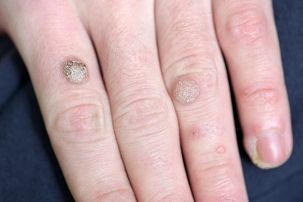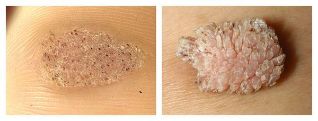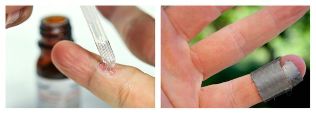What is a wart? We will analyze the causes of the article, diagnosis and treatment methods by a dermatologist with 37 years of experience.

Definition of diseases. Causes of the disease
Wartsis an irregular light-skinned benign skin lesion in the form of a localized excess of the upper layer of the skin (epidermis), with papules (nodules) or plaques.
The incidence of warts in adults is 7-12%, in school-age children - up to 10-20%.
Warts are very similar to other skin growths. Usually, a person can not accurately diagnose the disease on their own, so a dermatologist should be consulted to make a diagnosis.
Human papillomavirus is the cause of warts. The type of virus affects the type of warts that can develop. Thus, each type of human papillomavirus infects the tissue at its most characteristic localization.
| HPV type | Localize |
Types of warts |
|---|---|---|
| 1 | feet, elbows, palms, hands, fingers |
Plantar and palmar warts, Rarely simple warts |
| 2, 4 | hands, fingers, knees, less often - feet |
simple warts, sometimes plantar, palmar and mosaic warts |
| 3, 10 | Shiny, hands, face | Flat warts |
| 7 | hands, fingers | Butcher Warts |
| 5, 8, 9, 12, 14, 15, 17, 19-24 |
face, arms, anterior torso |
epidermodysplasia verroform |
Viral infection usually occurs through contact - through direct contact between infected and healthy skin (for example, when hands are shaken) or through indirect contact (handicrafts, toys, etc. ). Therefore, it is possible to be infected with the human papillomavirus, which causes warts in various places - on public transport, at school, at work, at home, in high contact and in humid environments (swimming pools, saunas, gyms). Minor trauma to the epidermis through which viruses enter, as well as inflammation of the skin, contributes to infection.
Also promotes the appearance of warts:
- Immunodeficiencies (including HIV);
- warm and humid environment;
- The need for professional contact with meat and fish ("Butcher Warts").
Some types of human papillomavirus are passed on from parents.
But toads and frogs, despite the horror stories we so often fear in childhood, can not be infected - this is one of the most popular myths about this disease, which has no basis.
If you have any of these symptoms, ask your doctor. Do not self-medicate - it is dangerous to health!
Wart symptoms
Symptoms vary depending on the type of wart.

Common wart:
- Normal color round dense papule, 1-10 mm and larger.
- The surface of the papule is covered with cracks, layers.
- If the papule has an image on the finger, the print disappears and is distorted. The same goes for the palm drawing.
- Simple warts are located once or in several parts - they are usually marked on the areas of greatest damage (hands, fingers, elbows). On examination with a dermatoscope, the doctor may see small brown spots - thrombosed (suppressed) capillaries. Patients often refer to these points as "roots. "This is the main sign for the doctor: it can be used by a dermatologist to distinguish purple from other similar diseases (e. g. , molluscum contagiosum and keratoma).
Plantar (horny) wart:
- The main symptom that a patient usually sees a doctor for is pain when stretching and walking.
- Such warts are usually localized on the feet.
- When you see a doctor, you usually see a normal-colored keratinized, uneven plaque, although in the first stage you may see an even, smooth papule. With keratinization, capillaries are seen only when the keratinized layer of the skin is removed.
- The base skin is distorted.
- Plantar warts are usually solitary, but there are also 2-6 warts;
- These warts are often confused with corn (especially dry) - this is a description of a problem that patients usually see.

flat (minor) wart:
- It looks normal, pink or brown, round, clear, smooth papilla, 1-5 mm in size.
- Appears on hands, shiny face, very often on face.
- There are always a few such warts - they are arranged in groups.
epidermodysplasia verrucifor (senile wart):
- Large, round, numerous attaching neoplasms of normal, pink or brown color.
- Most often appears on the face, arms, front of the torso.
- may be confused with keratoma, probe and skin cancers.
Pathogenesis of warts
Upon entering the body, a human papillomavirus can be dormant for a long time - a person usually does not even know it exists. When favorable factors appear on the virus, it begins to "multiply" in the epithelium, causing tissue changes.
Unlike other viruses, human papillomavirus does not destroy epithelial cells - they die on their own, naturally, in the process of keratinization and sore throat.Local factors and the state of the immune system influence the spread of infection. For example, people living with HIV or having a kidney transplant are more likely to develop warts. Moreover, the treatment of these neoplasms is often difficult. With normal immunity, the virus does not affect the deeper layers of the skin, so many people get warts on their own after a few months.
The main stage of the appearance of warts is the acceleration of cell division and growth rate with the help of the virus. This rapid metabolism causes the skin layers to thicken. Once the tissues grow in a certain, small area, a tubercle called a wart appears.
Wart classification and developmental stages
There is no generally accepted classification for warts. However, there are some common types:
- Common wart <strongx is the most common type (70% of warts are just that). Such neoplasms are not felt and only cause aesthetic discomfort to the person.
- Plantar wart <strong - occurs on the soles of the feet, is painful, and therefore requires treatment. Skin trauma due to uncomfortable, tight, hugged shoes contributes to the development of such a wart.
- Flat warts <strongx - more common in young adults. This occurs due to the unstable hormonal background of young people, which affects the whole body. Usually, flat warts are almost invisible.
- Senile warts <strongx - typical of the elderly. They often appear on the part of the body that is covered with clothing, but can occur on the face and hands. If there is no discomfort, such warts should not be treated - treatment in the elderly due to slow metabolism may be slower than in the young.

Other authors distinguish several types of warts:
- Mosaic Warts <strongx (HPV 2, 4) - neoplasms of the palms and soles of the feet. They resemble foci of hyperkeratosis, or thickening of the sternum cornea (usually anteriorly) covered with deep fissures.
- Cystic warts <strong (HPV 60) is a very rare species of foot with neoplasms. It is a soft knot with cracks. Upon opening, a white-yellow discharge appears like a curd.
- Fillet warts <strong thin horny branches near the mouth, nose or eyes.
- "Butchers" Warts(HPV 7) - Occurs on hands and fingers that are in constant contact with meat and fish. Presented as hypertrophic neoplasms similar to cauliflower but with normal color.
In addition, the types of warts are distinguished by their location.
So, anogenital warts - tumor-like neoplasms that appear on the genitals (especially in areas where the skin moves to the mucous membrane) are a common disease. They are mainly caused by HPV types 6 and 11.
Complications of warts
The main reason why warts go to the doctor is an aesthetic defect, which can affect the patient's quality of life, his self-confidence and develop numerous complexes. Complications may also include tearing the surface of the wart and adding to the infection, and in some warts, walking while walking.
Skin warts are not usually degenerative in malignant neoplasms, they are quite harmless, however, in very rare cases, such a complication may still occur in people with a suppressed immune system.
Other complications arise when removing neoplasms independently. In this regard, inflammation and aesthetic defects in the form of scars may develop, as well as the possibility of further spread of the virus through the skin, because of this, after self-examination of one wart in the morning, a person may wake up with several new ones.
Remember that warts can hide a completely different disease that cannot be diagnosed without the advice of an experienced doctor.

Diagnosis of warts
Usually, examination (clinical picture) and anamnesis (medical history) are sufficient to make a diagnosis. To confirm the diagnosis, the doctor may perform a histological examination - examination of neoplasm cells.It is very important to make a differential diagnosis - to distinguish warts from other diseases. For example,common wartsshould be distinguished from the following diseases:
- Molluscum contagiosum- more common on the body and genitals, less common on the hands and feet. It is a hemisphere that has an impression on the surface; When pressed from the sides, a white "gravel" opens.
- epidermal verrucous nevus- often solitary, a person has from birth. It rises above the surface of the skin, often covered with hair.
- Basalioma- Tumor in the form of a nodular roller, covered with a crust in the center. Typical of the elderly.
Palmar-plantar warts <strong> should be distinguished from the following diseases:
- Keratoderma- Large areas of keratinization and skin inflammation. No condensed capillaries.
- Palmer-plantar syphilis- Multiple painless neoplasms, scaling of the skin along the periphery. Syphilis has a positive reaction
- Corn- usually painless, can only cause pain when pressed vertically.
The doctor should also distinguish other types of warts from a number of diseases. If another pathology is suspected, he or she may schedule additional diagnoses (e. g. , detection of antibodies to viruses, CT, or MRI).
Wart treatment
Warts are treated for aesthetic purposes and to improve the patient's quality of life. It can be determined only after examination by a doctor and an accurate diagnosis. Independent attempts to escape from the wart are not allowed, because the patient without medical education and the necessary equipment can not accurately diagnose the disease, and after such "treatment" complications occur more often than recovery.
There are several ways to treat warts. Usually, all of them are held under the supervision of a doctor, and some of them - only in the treatment room of the clinic.

Chemical treatment
Colloidal milk-salicylic and salicylic pines are used to remove warts. The percentage of drugs and the method of their use (prolonged wearing of patches, applications, etc. ) depends on the prevalence and location of the neoplasm.
Solutions of zinc and 2-chloropropionic acid may also be used. In this case, the chemical composition is applied to a pre-treated surface that is left in the wart until the color changes (depending on the type of wart). The procedure is repeated several times after 7, 14 and 21 days. Before each procedure, the tissue is removed mechanically.
Another chemical method is a combination of nitrogen, acetic acid, oxyl, lactic acid, and copper nitrate trihydrate. In this way, only relatively small neoplasms are treated - up to 5 mm. The solution was also left to change the color of the wart. After 3-5 days, the patient comes after a further appointment, if necessary, he is prescribed a second procedure in 1-4 weeks.

Cryodestruction
This method involves freezing the liquid nitrogen wart: a moist tampon pressed against the damaged skin (by pressing the surrounding tissue for a few millimeters) for 1-5 minutes. Some lesions require repeated treatment within four weeks to be destroyed.
The main disadvantage of the cryptocurrency is its pain and delayed action compared to other methods, in which only one procedure is sufficient for sufficient removal.
Electrocoagulation
Under the influence of electric current, the wart opens in layers. Such surgery is performed under local anesthesia.
This method is more effective than cryodestruction, but it has a significant disadvantage: electrocoagulation often leaves behind scars at the site of wart removal. This method will not be suitable for patients trying to correct a cosmetic defect.
This method will not be suitable for patients trying to correct a cosmetic defect.
Laser Destruction
Thelaser also removes warts in layers. The light guide is applied to the skin for a few seconds to three minutes, depending on the size. The scar that appears is then removed, and the bottom of the wound is again treated with a laser. The patient is then instructed on how to deal with the wound. The operation itself is performed under the influence of local anesthesia.
Radiation surgery
Radiosurgery is one of the most modern and gentle methods of removing benign neoplasms, including warts.
Themethod is based on generating electromagnetic waves with different frequencies: from 100 kHz to 105 MHz. During the procedure, the tissues resist the conducting waves, causing molecular energy to build up in the cells, which warms the skin. Under the influence of heat, the cells actually evaporate - a neat cut is obtained. At the same time, no mechanical forces act on the affected tissue.
Pros of this method:
- protection;
- Fast wound healing;
- Good cosmetic effect - scars and scars are excluded;
- Relative painlessness - use local anesthetics before mini surgery; Elimination of secondary infection due to automatic disinfection of the electrode when the device is switched on.
The effectiveness of this method is recognized worldwide, but it is quite difficult to find a clinic that uses the method of radio wave surgery.
Which treatment method to choose
All of the above methods have several drawbacks:
- For the first two weeks, the operating area looks attractive - crusts, darkening of tissues. This should be taken into account if the warts are on visible parts of the body (for example, on the face).
- unpleasant odor and some degree of pain during surgery.
In addition, each of these methods has contraindications that you should read about in advance with your dermatologist.
But the main disadvantage is, that there is a high probability of recurrence, especially if the warts were wide. With each of these methods, from today doctors do not fight the root cause of the disease, but its consequencesIt is impossible to cure human papillomavirus.
Therefore, therapy is aimed at:
- or destruction of neoplasms that appear at the site of virus entry;
- or to stimulate an antiviral immune response;
- or a combination of these approaches.
The most commonly used destructive methods of treatment are used. Their efficiency reaches 50-80%.
Childhood is usually not a contraindication to surgical treatment. Therefore, many of them (including radio wave surgery) are also used to treat warts in children. The exception is the chemical removal of warts due to adverse reactions to the substance.
What to do after surgery
After any of these surgeries, be sure to follow your doctor's recommendations.
After any of the methods presented remove the tumor, the doctor will usually prescribe treatment for the removal site. It is forbidden to remove the "crusts" by hand, to cut the wound and to expose it to direct sunlight.
If a patient is constantly experiencing warts, then he or she should consult an immunologist - drug therapy may be needed to increase the immune system's resistance to the manifestations of human papillomavirus.
forecast. Prevention
If the patient does not have immunodeficiency problems, then the warts can go away on their own, but it will take a long time - from a few months to a few years. So in 65% of cases the warts regress independently within two years. If after two years the wart is still there, then it is recommended to remove it. It is recommended to remove the multiple growth immediately.
With normal immunity and properly chosen removal method (depending on the size and type of wart), it is possible to remove pathogenic tissue and achieve a good cosmetic effect. With reduced immunity and other predisposing factors, human papillomavirus remaining in the body causes relapses.
There is no specific disease prevention. But is infection so inevitable? ”X / p>
You can reduce the likelihood of a virus if you follow a few rules:
- Avoid walking barefoot in public places where skin damage and viral infections are possible (swimming pools, public showers, gyms).
- Choose quality shoes, change them often. Try to keep your feet dry. Heat and humidity are the basis of excellent papillomaviruses.
- To prevent peringular warts, go to a certified nail technician for manicures and make sure they use sterile tools.
The quadratic human papillomavirus vaccine is also effective in preventing anogenital warts, according to the World Health Organization (WHO). There are currently no vaccines available to prevent other types of warts.
If you find a single wart, then do not try to carefully cut, cut or avoid it - this way you will help prevent inflammation and further spread of the virus through the skin. After such "removal", instead of one wart in the morning, you can wake up with ten.














































































